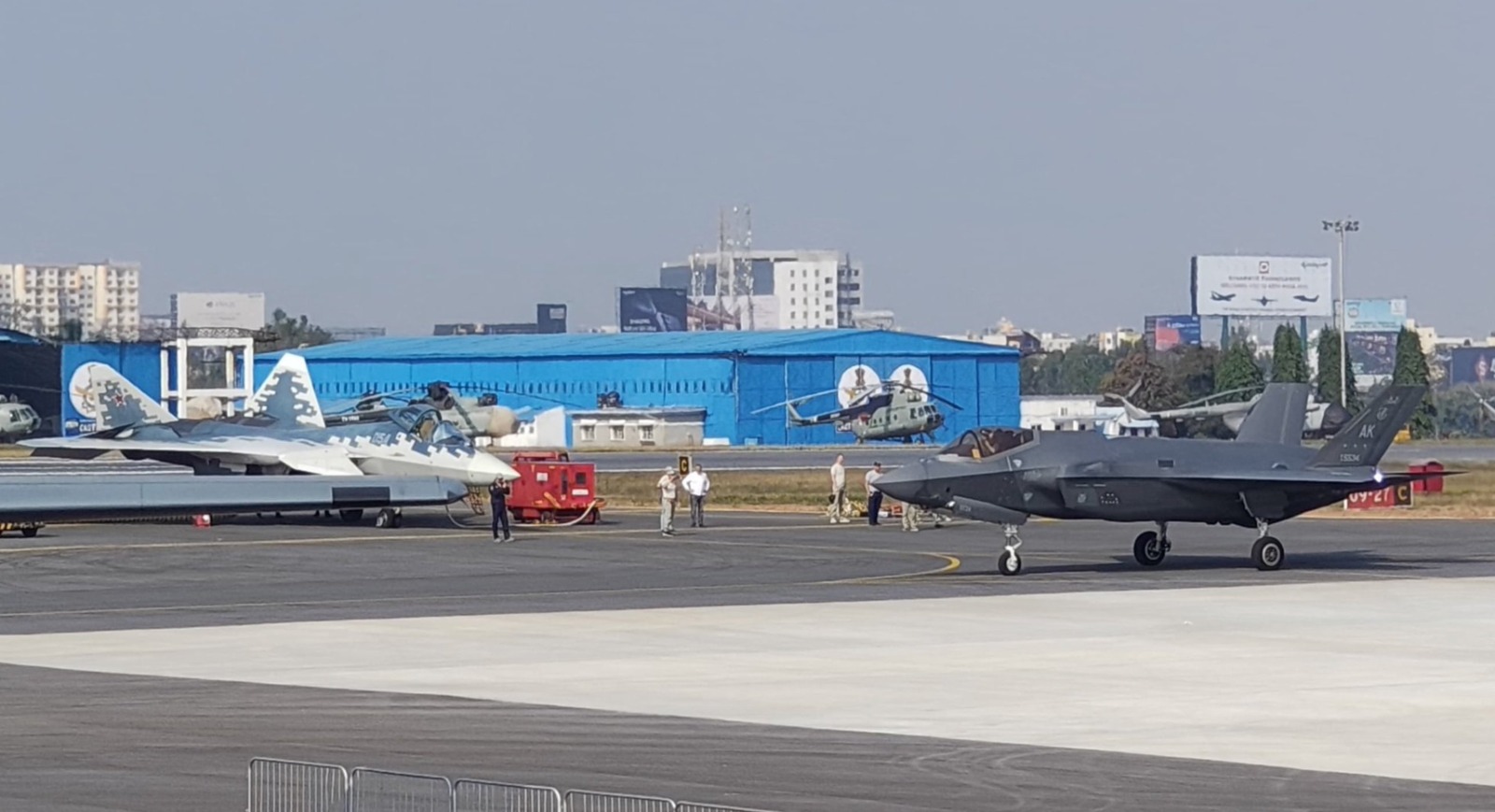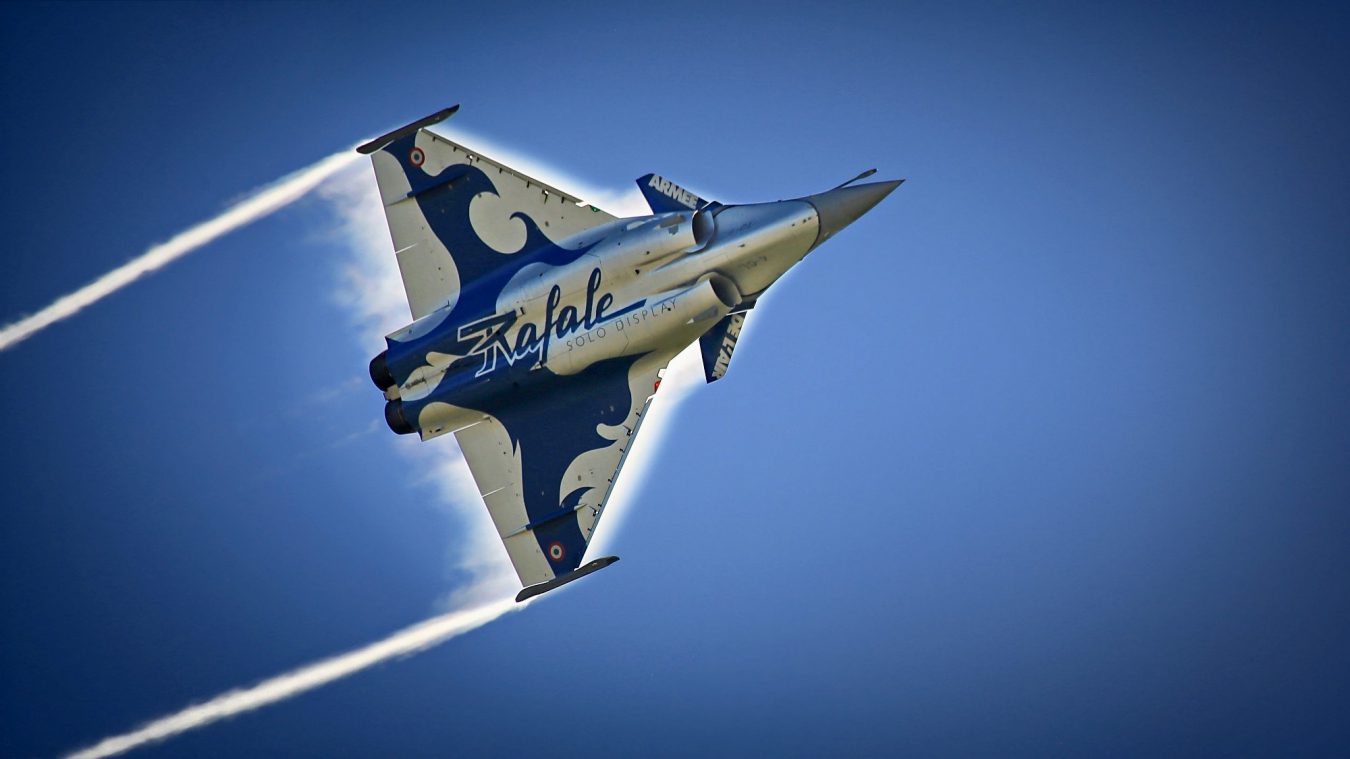Russia’s Su-57 and US-made F-35 Lighting II, two of the world’s most advanced fifth-generation fighter aircraft, are facing off at Aero India 2025 even as the Indian Air Force (IAF) is also trying to field its own stealth aircraft, AMCA. However, amid this iconic contest, some commentators have thrown their weight behind French Rafale fighters.
A flight demonstrator prototype of Russia’s Su-57E stealth fighter landed at Yelahanka Air Base in Bengaluru on February 6 ahead of Aero India 2025, which kicked off on February 10 and is slated to conclude on February 14. Russia has brought two Su-57 aircraft to the airshow: one for performing aerial demonstrations and the other for static display.
Along with this, Russia’s state arms exporter, Rosoboronexport, has also offered a “golden deal” to the IAF.
“Rosoboronexport proposes the all-round development of cooperation on the Su-57E project. Among our proposals is the supply of ready-made aircraft, the organization of their joint production in India, as well as assistance in the development of an Indian fifth-generation fighter,” Alexander Mikheev, Director General of Rosoboronexport, announced.
Adding more momentum to the pitch, Vadim Badekha, CEO of the United Aircraft Corporation (UAC), told reporters at Aero India that the aircraft facility in Komsomolsk-on-Amur has achieved a production pace that can meet the demand for Su-57 fifth-generation fighters both domestically and internationally, Russian state news agency TASS reported.
“The aircraft plant in Komsomolsk-on-Amur that is engaged in batch production of Su-57 has reached a good production pace that satisfies the growing demand of the Russian Defense Ministry and the ability to acquire the aircraft by our foreign partners,” he said.
The statement ostensibly seeks to dispel speculations that Russian aircraft production has been hit by the Ukraine War and crushing international sanctions.
The Russian offer is trying to address the innate sense of insecurity felt in India due to the rapid modernization of the Chinese People’s Liberation Army Air Force (PLAAF), which has already fielded over 200 J-20 stealth fighter jets. In contrast, the Indian fifth-generation ‘Advanced Medium Combat Aircraft’ (AMCA) will not enter service until 2034. By that time, China could deploy up to 1,000 J-20s.
The PLAAF has also unveiled the J-35A, a fifth-generation stealth fighter, and is concurrently advancing work on two sixth-generation fighter jets. Moreover, India’s arch-adversary, Pakistan, is poised to acquire about 40 J-35s from China, further widening India’s stealth gap with its two adversaries.
Su-57 Vs F-35
The Su-57’s debut at Aero India coincides with the visit of its rival stealth aircraft– the American F-35 Lightning II. The two aircraft were spotted on the same tarmac and captured in the same frame for the first time. Unlike the Su-57, the F-35 Lightning II has not been officially offered to India.
However, the presence of both these aircraft at Aero India 2025 has been interpreted as a potential contest for an IAF contract.
Regardless, it should be noted that the US has never explicitly stated that it would be open to selling the F-35 to India; even India has not shown great interest in cutting-edge stealth aircraft.
Indian military experts reckon that a sale of F-35 to India would not entail the transfer of technology or joint production, defeating India’s quest for Atmanirbharta (self-reliance) in defense. They have also argued that the purchase of F-35 would come at the cost of India’s long-held policy of strategic autonomy.
At the same time, military experts have also noted that the F-35 has better stealth characteristics. Writing for EurAsian Times, Squadron Leader Vijainder K. Thakur (retd), an IAF veteran and a seasoned military expert, said that the Su-57 is more of a defensive platform than an offensive one.
“The Su-57, with its limited stealth, is optimized for air defense and short-range airstrikes from within Russian airspace, aimed at halting enemy ground offensives along its borders,” Thakur noted.

However, as a country preparing for a two-front war, India might want a stealth aircraft better suited for penetrating hostile air defenses and launching preliminary strikes to obliterate vital air defenses and military infrastructure without being intercepted by the adversary. Experts have questioned whether the Su-57, with its limited stealth characteristics, would be ideal for that job.
Currently, the F-35 is ‘off the table’ for India, whereas the Su-57 does not offer the full range of capabilities that the IAF requires to deal with the twin threats posed by China and Pakistan.
However, some experts believe that instead of having to shoot too high for the F-35 or “settle” for the Su-57, it would be wiser for India to do the next best thing instead: buying more combat-proven French Rafales.
Rafale vs Su-57
In addition to adding a fifth-generation aircraft, India is also looking to acquire a multi-role fighter under its MRFA contract, which is expected to open soon.
The Indian Air Force (IAF) issued a Request for Information (RFI) to purchase 114 fighter jets under MRFA in 2018. While the program has remained in limbo for years since the RFI, several military analysts have thrown their weight behind the Rafale, one of the many contenders in the fray.
Speaking to EurAsian Times, Air Marshal Anil Khosla (retd) said, “We need to procure aircraft under the MRFA deal process to fill the gap, accelerate the project, increase the production rate of Tejas Mk-1A and Mk-2, and accelerate the AMCA project.”
“I recommend going for the already tested and inducted Rafale aircraft (in phases). Adding another type of aircraft will add to the already diverse inventory. Most contenders offer the listed benefits (ToT, Make in India, etc.). The extent of these offers needs to be assessed.”
Air Marshal Khosla emphasized, “Factors like life cycle cost, transfer of technology, Make in India, delivery schedule, aircraft performance, compatibility with already existing systems and weapons, etc., will be the deciding factors.”
If India were to place a big order for Rafales, it would act as a bridging solution for the IAF at a time when “India is stuck between the jaws of a vice for the risks associated with available options.”
Another IAF veteran, Air Marshal Anil Chopra (retd), suggested an alternative for fifth-generation fighters.
Chopra earlier told the EurAsian Times – “India could opt for the F4 or F5 variant of Rafale. It could buy 114 Rafale F4s under the MRFA contract, which will also allow local production and bolster the ‘Make in India’ policy. To top it all, it could buy the most advanced iteration of Rafale F5 to bridge the capability gap with adversaries.”
The comparison between the Su-57 and Rafale might not be straightforward, even though both are multi-role fighters and share a few similarities.
For instance, the Su-57 is a fifth-generation stealth fighter that is currently undergoing upgrades and integrating some sixth-generation technologies. In contrast, the Rafale is a 4.5th-generation aircraft with forward-hemisphere stealth and super-cruise capability.

The Su-57’s radar cross-section (RCS) is estimated to be between 0.1 and 0.5 square meters, likely lower than that of the Rafale.
In contrast, Dassault Aviation states, “The radar cross-section of the airframe has been kept to the lowest possible value by selecting the most adequate outer mold line and materials. Most of the stealth design features are classified, but some of them are visible, such as the serrated patterns on the trailing edge of the wings and canards.”
The proponents of Rafale argue in favor of its detection capability. The radar and sensor upgrades in the F4 variant of Rafale facilitate the detection of airborne stealth targets at long range. There are also improved capabilities in the helmet-mounted display. Additionally, improved communications equipment makes it more effective in network-centric warfare.
In one instance in 2009, Dassault Rafale successfully “shot down” a US Air Force F-22 Raptor in a simulated battle during a training exercise in the United Arab Emirates. After the US denied that the French aircraft had shot down the Raptor, the French released cockpit footage of the incident. Thus proving that the Rafale could hunt down a stealth fighter.
Moreover, the F5 variant of the aircraft is also believed to share some features with the next-generation aircraft being developed under the Future Combat Air System (FCAS) program.
The F5 variant will have new sensors, armaments, and a faster and more secure ability to communicate and collaborate. The aircraft will have a much better electronic warfare suite, with advanced capability for Suppression or Destruction of Enemy Defences (SEAD/DEAD), using the latest jamming systems and anti-radiation weapons.
The aircraft will be delivered to France before the end of this decade and could be acquired by India, as argued by Air Marshal Chopra.
While this does not mean that the Rafale is superior to the Su-57, there is a widespread belief that it would be more feasible for the IAF and help with interoperability. The IAF already operates 36 Rafale fighters, and the Indian Navy is geared toward acquiring 26 Rafale Marines.
While Russia has renewed the pitch for its Su-57 aircraft to India, emphasizing improvements in stealth, avionics, and combat capabilities, including the integration of hypersonic weapons, the decision of acquisition would be based on far wide-ranging aspects, including the geopolitics associated with such an acquisition.
- Contact the author at sakshi.tiwari9555 (at) gmail.com
- Follow EurAsian Times on Google News




